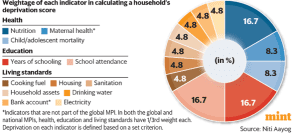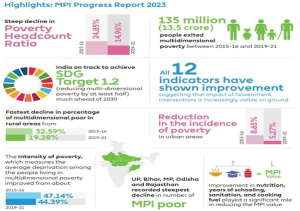THE CONTEXT: The NITI Aayog released the ‘National Multidimensional Poverty Index: A Progress Review 2023’. However, the Union government’s claim that there is a significant decline in poverty in recent years based on Multidimensional Poverty Index (MPI) is being questioned.
MULTIDIMENSIONAL POVERTY INDEX (MPI)
- NITI Aayog is the nodal agency for the National MPI which ranks States and UTs based on their performance. It has been responsible for constructing an indigenised index for monitoring the performance of States and Union Territories (UTs) in addressing multidimensional poverty.
- It captures overlapping deprivations in health, education and living standards to ascertain multidimensional poverty.
- Each of the specific parameters under 3 broad categories is assigned a value to calculate what is called a ‘deprivation score’. The deprivation score is the sum of the weighted status of all the indicators for an individual if it is more than 0.33, only then an individual is considered multidimensionally poor.

FINDING OF MPI, 2023:
- India has achieved a remarkable reduction in its MPI value and Headcount Ratio between 2015-16 and 2019-21. Uttar Pradesh (UP), Bihar, Madhya Pradesh (MP), Odisha and Rajasthan recorded steepest decline in number of MPI
- Improvement in nutrition, years of schooling, sanitation, and cooking fuel played a significant role in reducing the MPI
- The MPI estimates highlight a near-halving of India’s national MPI value and decline in the proportion of population in multidimensional poverty from 24.85% to 14.96% between 2015-16 and 2019-21.
- This reduction of 9.89 % in multidimensional poverty indicates that, at the level of projected population in 2021, about 135.5 million persons have escaped poverty between 2015-16 and 2019-21.
- Besides, the intensity of poverty, which measures the average deprivation among the people living in multidimensional poverty, reduced from 47.14% to 44.39%.

ISSUES IN MPI:
- Similar issues as UNDP’ HDI: United Nations Development Programme (UNDP) constructed an overall measure of human development with uniform weights of the three components. Following this methodology, NITI Aayog and the UNDP released recently a National Multidimensional Poverty Index/MPI: A Progress Review 2023. Hence, these reports suffer from the same flaws as the UNDP human development index aggregation with uniform weighting.
- Reliability on authenticity of data: The government had failed to provide access to authentic and unimpeachable data on many indicators. Rise in income alone cannot measure other dimensions of poverty such as access to healthcare, sanitation and transport. While the MPI should be seen in addition to data on income-level, the government was silent on income data. MPI relies upon National Family Health Survey (NFHS) 4 and NFHS 5, which are not detailed enough for its estimation. The government had not released a consumption expenditure survey conducted by the National Survey Organisation (NSO) in 2017-18. The NSO has announced consumption expenditure surveys for 2022-23 and 2023-24.
- Did not take into account pandemic situation: As a consequence of this pandemic, there was a huge economic shock from which the Indian economy has been struggling to recover. To illustrate, GDP growth has declined from 8% in 2015-16 to 3.78 % in 2019-20 and slumped -6.60 in 2020-21, as also per capita income. Country’s economy had not even gone back to the pre-pandemic level, this raises question of how such a large number of people had escaped poverty.
THE WAY FORWARD:
- Quality of data: There is a need to enhance the quality and availability of data on multidimensional poverty at more frequent intervals. It can be done by integrating the MPI into planning, budgeting, implementation and evaluation processes at all levels of government.
- Rigorous Analysis: There is a need of in-depth analysis of the parameters of multidimensional poverty at the national, State/UT, and district levels. It will help in development of the National MPI to act as public policy tool which monitors multidimensional poverty, informs evidence-based and focused interventions.
- Collaboration and coordination: There is a need to strengthen the coordination and convergence among different ministries, departments, agencies and stakeholders involved in addressing multidimensional poverty.
- Increase in investment: Government should focus on investments in critical areas as education, nutrition among others to eradicate poverty. It can be done through targeted policies, schemes, and developmental programmes rolled out at both the national and sub-national levels.
- Awareness: There is a need to increase the awareness and participation of civil society, media, academia and other actors in advocating for and monitoring multidimensional poverty reduction.
THE CONCLUSION:
Recently released MPI index have several lacunae which need reinterpretation to eradicate poverty with proper policy interventions. Consistent policy implementation across a diverse set of programmes and initiatives that have strong interlinkages will lead to a further reduction in deprivations across multiple indicators.
PREVIOUS YEAR QUESTION
Q.1 Though there have been several different estimates of poverty in India, all indicate a reduction in poverty levels over time. Do you agree? Critically examine with reference to urban and rural poverty indicators. (2015)
MAINS PRACTICE QUESTIONS
Q.1 Poverty impacts the social, economic and environmental aspects of the nation differently. Suggest the possible ways to eradicate poverty and achieve sustainable development goals in India.
Q.2 Recent assessment of poverty by Multidimensional Poverty Index (MPI) has been termed as flawed as the government estimates fail to paint an accurate picture of the realities. Critically analyse this statement.
Spread the Word

Related posts
LESSONS FROM THE CHOLA EMPIRE TO THE CONTEMPORARY INDIA
FROM SEAFLOOR RUPTURE TO SAFER SHORES: RE-IMAGINING TSUNAMI RISK GOVERNANCE FOR INDIA
MANGROVE RESTORATION AND COASTAL SECURITY IN INDIA